
1Paul M Dewick Medicalc Natural / booktext@id88013691placeboie
.pdf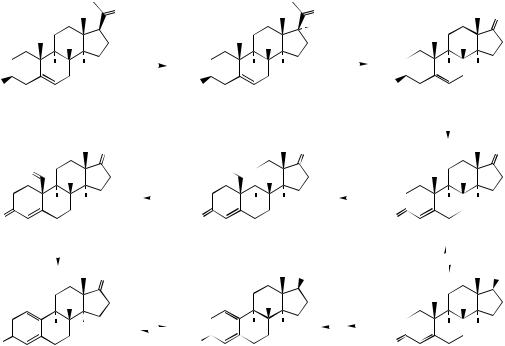
|
|
|
|
|
|
|
|
|
|
|
|
STEROIDS |
|
|
|
|
|
|
|
|
|
277 |
|
|
|
|
O |
|
17α-hydroxylation |
|
O |
|
|
oxidative removal of |
O |
||||||||||||
|
|
|
|
|
|
|
side-chain (Figure 5.134) |
||||||||||||||||
|
|
|
|
|
|
|
|
|
|
|
|
|
OH |
|
|
|
|||||||
|
|
|
17 |
|
|
|
|
|
|
|
|
|
|
|
|
|
|
|
|
|
|
|
|
|
|
|
H |
|
O2 |
|
H |
|
|
|
O2 |
|
|
H |
|||||||||
|
|
|
|
NADPH |
|
|
NADPH |
|
|
|
|||||||||||||
|
H |
H |
|
|
|
|
|
|
|
|
H |
H |
|
|
|
|
|
|
|
H |
H |
||
|
|
|
|
|
|
|
|
|
|
|
|
|
|
|
|
||||||||
HO |
|
|
|
|
|
|
|
HO |
|
|
|
|
|
|
|
|
|
HO |
|
||||
|
pregnenolone |
|
|
|
|
|
|
17α-hydroxypregnenolone |
|
|
|
|
|
|
|
dehydroepiandrosterone |
|||||||
|
|
|
|
|
|
|
|
|
|
|
|
|
|
|
|
|
|
|
|
|
|
|
oxidation of 3-hydroxyl |
|
|
|
|
|
|
|
|
|
|
|
|
|
|
|
|
|
|
|
|
|
NAD+ |
and tautomerism to |
|
|
|
|
|
sequential oxidation of C-10 |
|
|
|
|
|
|
|
|
|
|
conjugated system |
||||||||
|
|
|
O |
methyl to aldehyde |
|
O |
|
|
|
|
|
|
|
|
|
O |
|||||||
|
O |
H |
|
|
|
|
|
|
|
HO |
|
H |
|
|
O2 |
|
|
H |
|||||
|
|
|
|
|
O2 |
|
|
|
|
|
|||||||||||||
|
|
|
|
NADPH |
|
|
NADPH |
|
|
|
|||||||||||||
|
H |
H |
|
|
|
|
|
|
|
|
H |
H |
|
|
|
|
|
|
|
H |
H |
||
|
aromatase |
aromatase |
|||||||||||||||||||||
O |
|
|
|
|
|
|
|||||||||||||||||
|
|
|
|
|
|
|
O |
|
|
|
|
|
|
|
|
|
O |
|
|||||
|
O2 |
|
oxidative loss of C-10 |
|
|
|
|
|
|
|
|
|
androstenedione |
||||||||||
|
|
formyl and aromatization |
|
|
|
|
|
|
|
|
|
|
|
|
|||||||||
|
NADPH |
|
of ring A (Figure 5.135) |
|
|
|
|
|
|
|
|
|
|
|
NADH/ |
||||||||
aromatase |
|
|
|
|
|
|
|
|
|
|
|
NADPH |
|||||||||||
|
|
|
|
|
|
|
|
|
|
|
|
|
OH |
|
|
|
|
|
|
|
|
|
|
|
|
|
O |
|
|
|
|
|
|
|
|
|
|
|
|
|
|
|
|
|
|
OH |
|
|
|
|
|
|
|
|
|
|
|
|
|
|
|
|
|
|
|
|
|
|
|||
|
|
|
H |
NADH/ |
|
H |
O2 |
|
|
H |
|||||||||||||
|
|
|
|
NADPH |
|
|
|
NADPH |
|
|
|
||||||||||||
|
H |
H |
|
|
|
|
|
|
|
|
H |
H |
|
|
|
|
|
|
|
H |
H |
||
|
|
|
|
|
|
|
|
|
aromatase |
||||||||||||||
|
|
|
|
|
|
|
|
|
|||||||||||||||
HO |
|
|
|
|
|
|
|
HO |
|
|
O |
|
|||||||||||
|
|
|
|
|
|
|
|
|
|
|
|
|
|
|
|
|
|||||||
|
estrone |
|
|
|
|
|
|
|
|
estradiol |
|
|
|
|
|
|
|
testosterone |
|||||
|
(oestrone) |
|
|
|
|
|
|
|
|
(oestradiol) |
|
|
|
|
|
|
|
|
|
|
|||
Figure 5.133
progesterone, as well as the next step in oestrogen biosynthesis, and it plays a significant role in controlling the direction of steroid synthesis. Whilst 17α-hydroxyprogesterone is transformed by 21-hydroxylation for hydrocortisone biosynthesis, in oestrogen biosynthesis the α- hydroxyketone function is oxidized from 17α- hydroxypregnenolone, cleaving off the two-carbon side-chain as acetic acid. The product is the 17-ketone dehydroepiandrosterone, which is the most abundant steroid in the blood of young adult humans, with levels peaking at about 20 years of age, then declining as the person ages. Apart from its role as a precursor of hormones, it presumably has other physiological functions, though these still remain to be clarified. A mechanism for the sidechain cleavage reaction, initiated by attack of an enzyme-linked peroxide, is shown in Figure 5.134, and is analogous to that proposed for loss of the 14-methyl group during cholesterol biosynthesis (see page 235). Oxidation and tautomerism in rings A/B then give androstenedione (Figure 5.133). Either androstenedione, or its reduction product
testosterone, is a substrate for aromatization in ring A, with loss of C-19. This sequence is also catalysed by a single cytochrome P-450-dependent enzyme, called aromatase, and the reaction proceeds via sequential oxidation of the methyl, with its final elimination as formic acid (Figure 5.135). The mechanism suggested is analogous to that of the side-chain cleavage reaction. Formation of the aromatic ring is then a result of enolization. As with other steroid hormones, the exact order of some of the steps, including formation of the ∆4- 3-keto function, 17-hydroxylation, reduction of the 17-keto, and aromatization in ring A, can vary according to organism, or site of synthesis in the body. Since breast tumours require oestrogens for growth, the design of aromatase inhibitors has become an important target for anticancer drug research.
The aromatic ring makes the oestrogen molecule almost planar (see page 233) and is essential for activity. Changes which remove the aromaticity, e.g. partial reduction, or alter stereochemistry, give analogues with reduced or no activity.
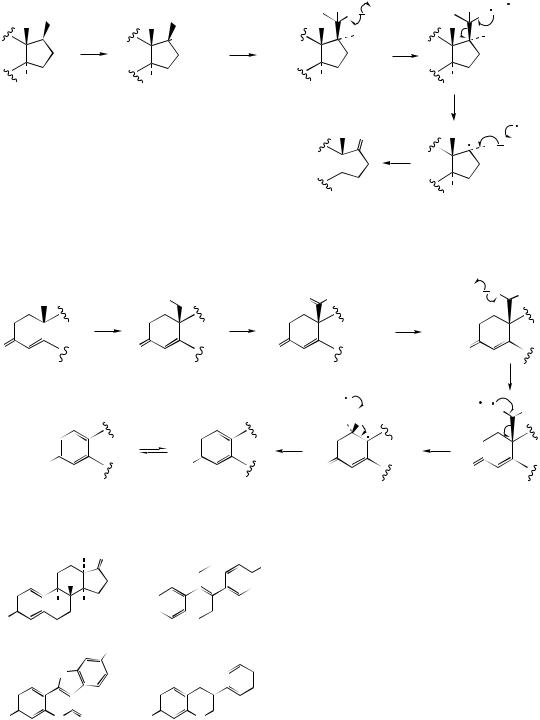
278 |
THE MEVALONATE AND DEOXYXYLULOSE PHOSPHATE PATHWAYS |
17α-hydroxylation
 O
O
O2
17 |
NADPH |
peroxy adduct formation via nucleophilic attack of peroxy-enzyme on to carbonyl
 O
O
 OH O2
OH O2
NADPH
homolytic cleavage |
|
|
of peroxy bond |
|
|
OH |
OH |
O–Fe–Enz |
O O–Fe–Enz |
O |
|
OH |
OH |
|
H |
|
Enz–Fe–OOH |
H |
|
|
side-chain lost |
|
H |
|
|
H |
as acetic acid |
|||
|
|
|
|
|
CH3CO2H |
||
|
|
|
|
O |
|
|
O–Fe–Enz |
|
|
|
|
|
O |
H |
|
|
|
|
|
|
|
||
|
|
|
H |
|
H |
|
|
|
|
Figure 5.134 |
|
|
|
|
|
|
|
|
peroxy adduct formation via |
|
homolytic cleavage |
||
|
sequential oxidation of C-10 methyl to aldehyde |
nucleophilic attack of |
|
of peroxy bond |
|||
|
peroxy-enzyme on to carbonyl |
|
|
|
|||
|
|
|
|
|
|
||
|
HO |
|
O H |
|
Enz–Fe–O |
O |
OH |
|
|
|
|
|
|
||
|
O2 |
O2 |
|
O2 |
|
|
|
|
NADPH |
NADPH |
|
NADPH |
|
|
|
10 |
|
|
|
|
|
||
|
|
|
|
|
|
|
|
O |
O |
|
O |
Enz–Fe–OOH |
O |
|
|
|
|
|
|
||||
|
|
|
Enz–Fe–O |
HCO2H |
Enz–Fe–O |
O |
OH |
|
enolization |
|
H |
H |
|
|
|
|
|
|
|
|
|
|
|
HO |
O |
|
O |
|
O |
|
|
|
|
|
|
side-chain lost |
|
|
|
as formic acid
Figure 5.135
|
|
|
O |
|
|
|
|
|
|
|
|
|
|
|
|
|
|
|
OH |
|
H |
13 |
|
|
|
|
|
|
|
|
|
|
|
|
|
|
|
||
|
|
|
|
|
|
|
|
|
|
|
H |
H |
|
|
|
|
|
|
|
|
|
|
|
|
|
|
|
||
HO |
|
|
HO |
|
|
|
|
|
|
|
lumiestrone |
|
|
diethylstilbestrol |
|||||
|
|
|
OH |
(stilboestrol) |
|||||
|
|
|
|
|
|
|
|
||
|
O |
|
|
R |
O |
|
OH |
||
|
|
|
|
|
|||||
|
|
|
|
||||||
|
|
|
|
|
|
|
|
|
|
|
|
|
|
|
|
|
|
|
|
|
|
|
|
|
|
|
|
|
|
HO |
O |
O |
HO |
O |
|||||
|
coumestrol |
|
|
R = H, daidzein |
|||||
|
|
|
|
R = OH, genistein |
|||||
Figure 5.136
Thus, exposure of estrone to UV light leads to inversion of configuration at C-13 adjacent to the carbonyl function, and consequently formation of a cis-fused C/D ring system. The product, lumiestrone (Figure 5.136) is no longer biologically active. Some planar non-steroidal structures can also demonstrate oestrogenic activity as a result of a similar shape and relative spacing of oxygen functions. Thus, the synthetic diethylstilbestrol (stilboestrol) (Figure 5.136) has been widely used as an oestrogenic drug, and coumestrol, daidzein, and genistein (Figure 5.136) are naturally occurring isoflavonoids with oestrogenic properties from lucerne, clovers, and soya beans, and are termed

STEROIDS |
279 |
Oestrogen Drugs
Oestrogens suppress ovulation and with progestogens form the basis of combined oral contraceptives and hormone replacement therapy (HRT). They are also used to supplement natural oestrogen levels where these are insufficient as in some menstrual disorders, and to suppress androgen formation and thus tumour growth of cancers dependent on androgens, e.g. prostate cancers. Oestrogens appear to offer a number of beneficial effects to women, including protection against osteoporosis, heart attacks, and possibly Alzheimer’s disease. However, some cancers, e.g. breast and uterine cancers, are dependent on a supply of oestrogen for growth, especially during the early stages, so high oestrogen levels are detrimental. Steroidal oestrogens for drug use were originally obtained by processing pregnancy urines, but the dramatic increase in demand due to the introduction of oral contraceptives required development of semi-synthetic procedures. Androstenolone formed via the Marker degradation of diosgenin (Figure 5.129) may be transformed to the dione by catalytic reduction of the ∆5 double bond and oxidation of the 3-hydroxyl (Figure 5.137). This then allows production of androstadienedione by dibromination and base-catalysed elimination of HBr. Alternatively, it is now possible to achieve the synthesis of androstadienedione in a single step by a microbiological fermentation of either sitosterol obtained from soya beans (see page 256), or of cholesterol obtained in large quantities from the woolfat of sheep, or from the spinal cord of cattle (see page 236). These materials lack unsaturation in the side-chain and were not amenable to simple chemical oxidation processes, as for example with stigmasterol (see page 266). Their exploitation required the development of suitable biotransformations, and use of Mycobacterium phlei has now achieved this objective (Figure 5.137). The aromatization step to estrone can be carried out in low yields by vapour-phase free-radical-initiated thermolysis, or more recently with considerably better yields using a dissolving-metal reductive thermolysis. In both processes, the methyl at C-10 is lost. This sequence gives estrone, from which estradiol (oestradiol) may be obtained by reduction of the 17-carbonyl. However, by far the most commonly used medicinal estrogen is ethinylestradiol (ethinyloestradiol) (Figure 5.137), which is 12 times as effective as estradiol when administered orally. This analogue can be synthesized from estrone by treatment with potassium acetylide in liquid ammonia, which attacks from the less-hindered α-face (see page 273). The ethynyl substituent prevents oxidation at C-17, as in the metabolism of estradiol to the less active estrone. The phenol group allows synthesis of other derivatives, e.g. the 3-methyl ether mestranol (Figure 5.137), which acts as a pro-drug, being oxidized in the liver to ethinylestradiol. To retain oestrogenic activity, structural modifications appear effectively limited to the addition of the 17α-ethynyl group, and to substituents on the 3-hydroxyl. The ester estradiol valerate (oestradiol valerate) facilitates prolonged action through slower absorption and metabolism.
The lower activity metabolites estriol (oestriol) (about 2% activity of estradiol) and estrone (oestrone) (about 33% activity) (Figure 5.132) are sometimes used in hormone replacement therapy (HRT). Oestrogen and progesterone levels decline naturally at menopause when the menstrual cycle ceases. The sudden reduction in oestrogen levels can lead to a number of unpleasant symptoms, including tiredness, hot flushes, vaginal dryness, and mood changes. HRT reduces these symptoms, and delays other long-term consequences of reduced oestrogen levels, including osteoporosis and atherosclerosis. HRT currently provides the best therapy for preventing osteoporosis, a common disease in post-menopausal women.
(Continues)
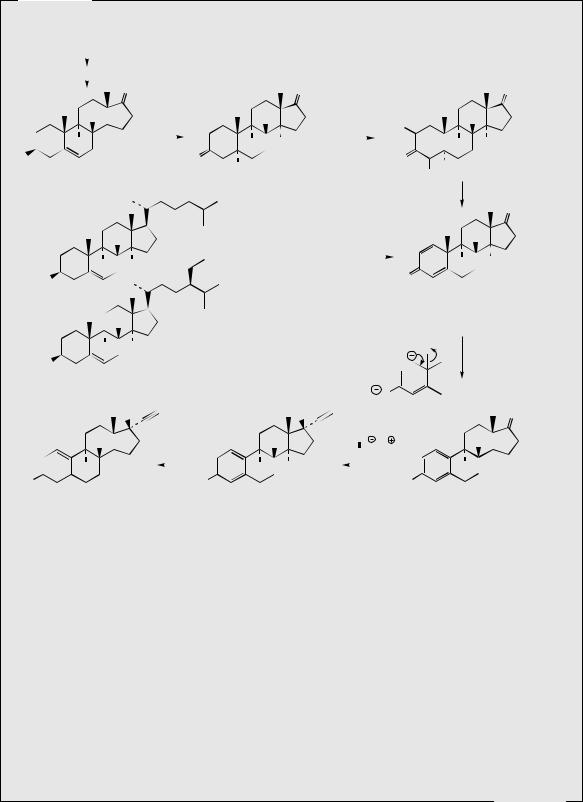
280 |
THE MEVALONATE AND DEOXYXYLULOSE PHOSPHATE PATHWAYS |
(Continued )
diosgenin |
|
|
|
|
Marker |
|
|
|
|
degradation and |
|
|
|
|
removal of |
|
reduction of double bond; oxidation |
||
side-chain |
|
|||
(Figure 5.129) |
O |
of 3-hydroxyl |
O |
|
|
|
|
||
|
H |
i H2 / catalyst |
H |
|
|
|
ii CrO3 |
|
|
H |
H |
|
H |
H |
|
||||
HO |
|
|
O |
|
androstenolone |
|
H |
|
|
|
|
|
||
|
brominations |
|
O |
|
|
α to ketone |
|
||
Br2 / HOAc |
Br |
H |
||
|
||||
|
|
|
H |
H |
|
|
|
||
|
|
|
O |
base-catalysed |
|
|
|
H |
eliminations |
|
|
|
Br |
|
|
|
|
|
|
|
|
|
|
collidine / ∆ |
|
H |
|
cholesterol |
Mycobacterium phlei |
|
|
|
|
|||
|
|
|
|
||
H |
|
H |
or |
|
|
|
|
|
|||
|
|
|
|
||
HO |
|
|
sitosterol |
|
O |
H
H  H
H
HO
|
|
|
|
|
|
|
|
|
O |
|
|
OH |
|
SN2 alkylation of |
OH |
|
|
|
|||
|
|
|
phenol |
|
|
|
|
|||
|
H |
Me2SO4 |
|
|
H |
HC C Na |
||||
|
H H |
|
H |
H |
|
liq NH3 |
||||
|
|
|||||||||
|
|
|
|
|
|
|
HO |
|||
MeO |
|
|
HO |
|
|
|
||||
|
mestranol |
|
|
|
|
ethinylestradiol |
nucleophilic attack of |
|||
|
|
|
|
|
|
(ethinyloestradiol) |
acetylide anion on to |
|||
|
|
|
|
|
|
|
|
carbonyl from |
||
|
|
|
|
|
|
|
|
less-hindered α face |
||
O
H
H  H
H
androstadienedione
vapour-phase radical-initiated thermolysis
tetralin / ∆ / 600° or
Li /biphenyl / 66°
dissolving metal reduction
O
H
H  H
H
estrone (oestrone)
Figure 5.137
Osteoporosis is characterized by a generalized loss of bone mass leading to increased risk of fracture, and a sharp reduction in endogenous oestrogen levels is recognized as a critical factor. Oestrogen and progestogen combinations are used in HRT unless the woman has had a hysterectomy, in which case oestrogen alone is prescribed. Natural oestrogen structures are preferred to synthetic structures such as ethinylestradiol or mestranol. Before the availability of plant-derived semi-synthetic oestrogens, extraction of urine from pregnant women and pregnant horses allowed production of oestrogen mixtures for drug use. Conjugated equine oestrogens are still widely prescribed for HRT and are obtained by extraction from the urine of pregnant mares and subsequent purification, predominantly in Canada and the USA. Mares are about 120 days pregnant when urine collection begins, and collection continues for another 150–160 days. During this period, a mare will produce about 400–500 litres of urine.
(Continues)
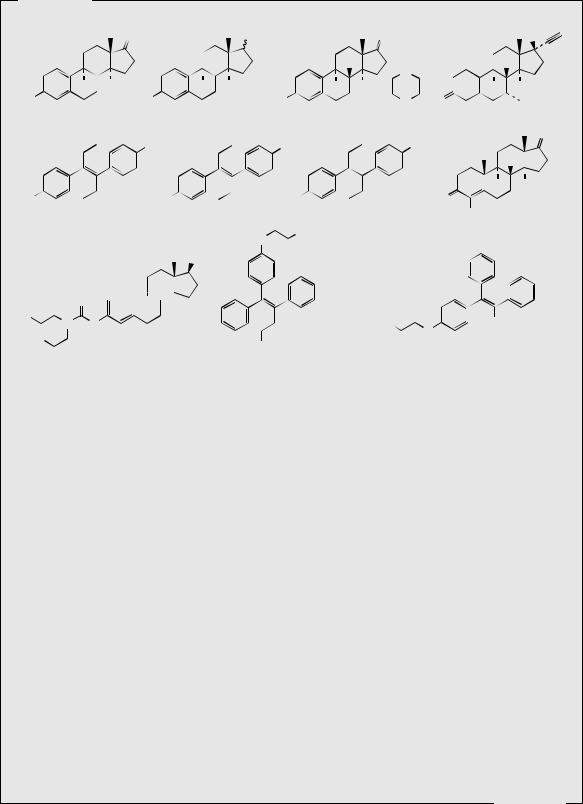
STEROIDS |
281 |
(Continued )
|
|
O |
|
|
|
|
OH |
|
|
O |
|
|
|
OH |
|||
|
|
|
|
|
|
|
17 |
|
|
|
|
|
|
|
|
|
|
|
|
|
|
|
|
|
|
|
|
|
H |
H |
|
H |
|
||
|
|
|
|
|
|
|
|
|
|
|
|
|
|
N |
|
|
|
|
H |
H |
|
|
H |
H |
|
|
|
H |
|
H + |
|
|
H |
H |
|
HO |
HO |
HO3SO |
|
|
|
N |
O |
|
|||||||||
|
equilin |
|
dihydroequilin |
|
|
|
estropipate |
H |
|
tibolone |
|
||||||
|
|
|
|
|
|
|
|
|
|
|
|
|
|
|
|
|
O |
|
|
|
OH |
|
OP |
|
|
|
|
OH |
|
||||||
|
|
|
|
|
|
|
|
|
|
|
|
|
|
|
|
H |
|
|
|
|
|
|
|
|
|
|
|
|
|
|
|
|
|
|
|
|
|
|
|
|
|
|
|
|
|
|
|
|
|
|
|
H |
H |
|
|
|
|
|
|
|
|
|
|
|
|
|
|
|
|
||
HO |
PO |
|
HO |
|
|
|
|
O |
|
||||||||
|
diethylstilbestrol |
|
|
fosfestrol |
|
|
|
|
dienestrol |
|
OH |
|
|||||
|
(stilboestrol) |
|
|
|
|
|
|
NMe2 |
(dienoestrol) |
|
|
formestane |
|||||
|
|
|
|
|
|
|
|
|
|
|
|
|
|
|
|
||
|
|
|
|
|
|
|
O |
|
|
|
|
|
|
|
|||
OH
H
O 


 H H
H H
Cl
N O
Cl
estramustine
Me2N |
|
Cl |
|
||
R = H, tamoxifen |
O |
|
|
|
|
R R = Cl, toremifene |
clomifene (clomiphene) |
|
Figure 5.138
Horses are maintained in an almost continuous state of pregnancy, and need to be kept in confined stalls and fitted with a suitable urine collection device, though the use of catheters to collect urine has been discontinued. Animal welfare groups urge women to reject these drug preparations in favour of plant-derived alternatives. Conjugated equine oestrogens provide a profile of natural oestrogens based principally on estrone and equilin (Figure 5.138). It consists of a mixture of oestrogens in the form of sodium salts of their sulphate esters, comprising mainly estrone (50–60%) and equilin (20–30%), with smaller amounts of 17α-dihydroequilin, 17α-estradiol, and 17β-dihydroequilin. The semisynthetic estropipate is also a conjugated oestrogen, the piperazine salt of estrone sulphate.
The structure of tibolone (Figure 5.138) probably resembles that of a progestogen more than it does an oestrogen. Although it does not contain an aromatic A-ring, the 5(10)-double bond ensures a degree of planarity. This agent combines both oestrogenic and progestogenic activity, and also has weak androgenic activity, and has been introduced for treatment of vasomotor symptoms of menopause.
Diethylstilbestrol (stilboestrol) and dienestrol (dienoestrol) (Figure 5.138) are the principal non-steroidal oestrogen drugs, used topically via the vagina. Fosfestrol (Figure 5.138) has value in the treatment of prostate cancer, being hydrolysed by the enzyme phosphatase to produce diethylstilbestrol as the active agent.
In estramustine (Figure 5.138), estradiol is combined with a cytotoxic alkylating agent of the nitrogen mustard class via a carbamate linkage. This drug has a dual function, a hormonal effect by suppressing androgen (testosterone) formation, and an antimitotic effect from the mustine residue. It is of value in treating prostate cancers.
(Continues)
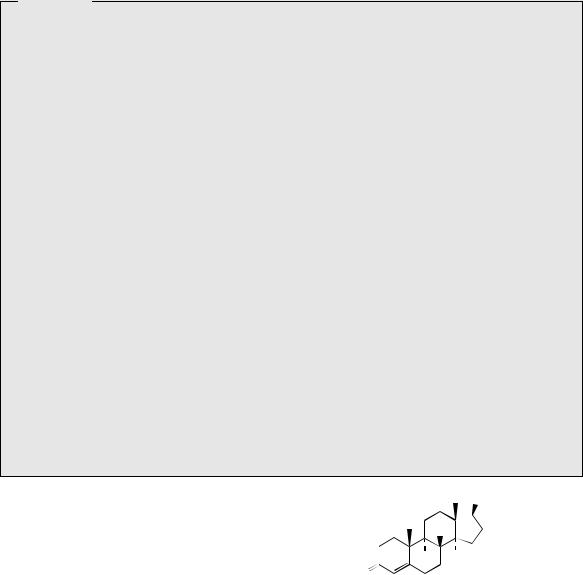
282 |
THE MEVALONATE AND DEOXYXYLULOSE PHOSPHATE PATHWAYS |
(Continued )
Phyto-oestrogens are predominantly isoflavonoid derivatives found in food plants and are used as dietary supplements to provide similar benefits to HRT, especially in countering some of the side-effects of the menopause in women. These compounds are discussed under isoflavonoids (see page 156). Dioscorea (wild yam) root or extract (see page 239) is also marketed to treat the symptoms of menopause as an alternative to HRT. Although there is a belief that this increases levels of progesterone, which is then used as a biosynthetic precursor of other hormones, there is no evidence that diosgenin is metabolized in the human body to progesterone.
Aromatase Inhibitors
Formestane (Figure 5.138), the 4-hydroxy derivative of androstenedione, represents the first steroid aromatase inhibitor to be used clinically. It reduces the synthesis of oestrogens and is of value in treating advanced breast cancer in post-menopausal patients.
Oestrogen Receptor Antagonists
Breast cancer is dependent on a supply of oestrogen, and a major success in treating this disease has been the introduction of tamoxifen (Figure 5.138). This drug contains the stilbene skeleton seen in diethylstilbestrol and related oestrogens, but acts as an oestrogen-receptor antagonist rather than as an agonist in breast tissue, and deprives the cells of oestrogen. However, it is an agonist in bone and uterine tissue. The chlorinated analogue toremifene is also available, but is used primarily in post-menopausal women. Oestrogen antagonists can also be used as fertility drugs, occupying oestrogen receptors and interfering with feedback mechanisms and leading to ova release. Clomifene (clomiphene) (Figure 5.138), and to a lesser extent tamoxifen, are used in this way, but can lead to multiple pregnancies.
phyto-oestrogens (see page 156). Dietary natural isoflavonoids are believed to give some protection against breast cancers, and are also recommended to alleviate the symptoms of menopause.
Androgens
The primary male sex hormone, or androgen, is testosterone (Figure 5.139). This is secreted by the testes and is responsible for development and maintenance of the male sex characteristics. Androgens also have a secondary physiological effect, an anabolic activity which stimulates growth of bone and muscle, and promotes storage of protein. The biosynthetic pathway to testosterone is outlined in Figure 5.133, where it can feature as an intermediate in the pathway to oestrogens. Low levels of testosterone are also synthesized in females in the ovary. Testosterone
OH
 17
17
|
H |
3 |
H H |
4 |
|
O |
testosterone |
|
Characteristic features of androgens:
•C19 androstane skeleton
•no side-chain
•∆4-3-keto
•17β-hydroxyl
Figure 5.139
lacks any side-chain and has a 17β-hydroxyl as in estradiol, but still contains the methyl C-19 and the ∆4-3-one system in ring A. This C19 skeleton is designated androstane.
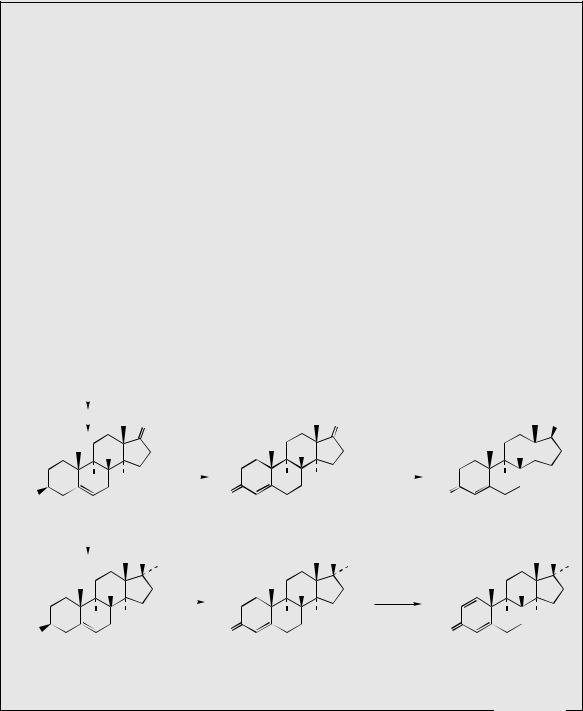
STEROIDS |
283 |
It is particularly worthy of note that the routes to corticosteroids, progestogens, oestrogens, and androgens involve common precursors or partial pathways. This means that these processes need to be under very tight control if
a person’s normal physiological functions and characteristics are to be maintained. This balanced production is regulated primarily by gonadotrophic and hypothalamic proteins from the pituitary (see page 411).
Androgen Drugs
Testosterone can be produced from androstenolone (Figure 5.129) by chemical routes requiring reduction of the 17-carbonyl and oxidation of the 3-hydroxyl, and necessitating appropriate protecting groups. A simple high-yielding process (Figure 5.140) exploits yeast, in which fermentation firstly under aerobic conditions oxidizes the 3-hydroxyl, and then in the absence of air reduces the 17-keto group. Testosterone is not active orally since it is easily metabolized in the liver, and it has to be implanted, or injected in the form of esters. Transdermal administration from impregnated patches has also proved successful, and is now the method of choice for treating male sexual impotence caused by low levels of sex hormones (hypogonadism). Testosterone may also be prescribed for menopausal women as an adjunct to hormone replacement therapy (see page 279) to improve sex drive, and occasionally in the treatment of oestrogen-dependent breast cancer. The ester testosterone undecanoate is orally active, as is mesterolone (Figure 5.141), which features introduction of a 1α-methyl group and reduction of the ∆4 double bond. Oral activity may also be attained by adding a 17α-alkyl group to reduce metabolism, e.g. 17α-methyltestosterone (Figure 5.140), such groups being introduced using appropriate Grignard reagents. However, these types of 17α-alkyl derivative are being replaced since they can sometimes cause jaundice as a side-effect.
The ratio of androgenic to anabolic activity can vary in different molecules. There have been attempts to produce steroids with low androgenic but high anabolic activity to use for various
diosgenin
Marker |
|
|
|
under aerobic conditions get |
|
||||
|
|
|
|
||||||
|
|
|
oxidation of 3β-hydroxyl leading |
||||||
degradation and |
|
|
|
||||||
|
|
||||||||
removal of |
|
|
O |
to ∆4-3-ketone |
O |
||||
|
|||||||||
side-chain |
|
|
|
|
|
|
|
||
|
|
|
|
|
|
||||
(Figure 5.129) |
|
|
|
|
|
|
|
||
|
|
|
H |
|
|
yeast |
H |
||
|
|
|
|
|
|
O2 |
|
||
|
|
H |
H |
|
|
|
|
H |
H |
|
|
|
|
|
|
||||
HO |
|
|
|
|
|
O |
|
||
androstenolone |
|
|
|
|
|
|
|||
|
|
|
nucleophilic attack on to |
|
|||||
MeMgI |
|
|
carbonyl from less-hindered α face |
|
|||||
|
|
|
OH |
|
|
|
|
|
OH |
|
|
|
H |
|
|
|
|
|
H |
|
|
H |
H |
|
|
|
|
H |
H |
|
|
|
|
|
|
||||
HO |
|
|
|
|
|
O |
|
||
|
|
|
|
|
|
|
|
17α-methyltestosterone |
|
under anaerobic conditions get reduction of 17-ketone
OH
yeast |
H |
|
no O2 |
|
|
|
H |
H |
|
||
O
testosterone
OH
chemical or |
H |
microbiological |
H  H
H
O methandienone
Figure 5.140
(Continues)
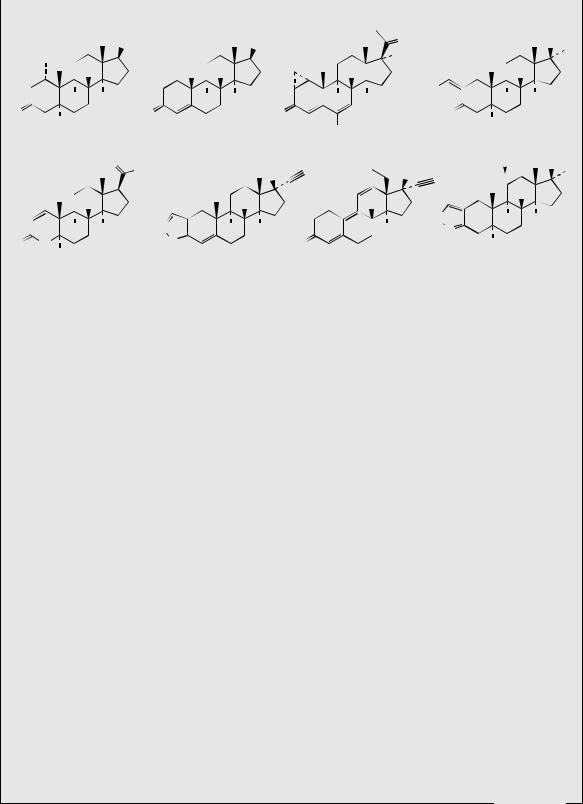
284 |
|
|
THE MEVALONATE AND DEOXYXYLULOSE PHOSPHATE PATHWAYS |
|
||||||
|
(Continued ) |
|
|
|
|
|
|
|
|
|
|
|
|
OH |
OH |
O |
|
|
OH |
||
|
|
|
|
|
|
|||||
|
|
|
|
|
|
|
OAc |
|
|
|
|
H |
|
H |
H |
H |
|
H |
|
||
|
H |
H |
|
H |
H |
HO |
H |
H |
||
|
|
H H |
||||||||
O |
|
O |
O |
|
O |
|
||||
|
H |
|
|
|
|
Cl |
H |
|
||
|
mesterolone |
|
nandrolone |
oxymetholone |
||||||
|
|
cyproterone acetate |
||||||||
|
|
|
|
(19-nortestosterone) |
H2NNH2 |
|
|
|||
|
|
|
|
|
|
|||||
|
|
|
|
O |
|
|
|
OH |
||
|
|
|
|
NHtBu |
OH |
OH |
|
|
|
|
|
|
|
|
|
|
|
|
|
||
|
H |
|
|
|
H |
H |
|
H |
|
|
|
|
|
|
|
|
|
||||
|
H |
H |
|
|
|
HN |
H |
H |
||
|
N |
|
H H |
H |
N |
|
||||
|
|
|
|
O |
|
|
|
|||
O N |
|
|
O |
H |
|
|||||
|
H H |
|
|
|
|
|
stanozolol |
|
||
|
finasteride |
|
danazol |
gestrinone |
|
|
|
|||
Figure 5.141
metabolic and endocrine disorders. Methandrostenolone (methandienone) (Figure 5.140), oxymetholone, and nandrolone (19-nortestosterone) (Figure 5.141) are modifications used in this way. Treatment of oxymetholone with hydrazine leads to formation of a pyrazole ring fused to a saturated ring A as seen in stanozolol (Figure 5.141). However, it is difficult to completely remove the androgenic activity from anabolic steroids. These materials are frequently abused by athletes wishing to promote muscle development and strength. Androgenic activity can affect the sexual characteristics of women, making them more masculine, whilst prolonged use of these drugs can lower fertility in either sex and endanger long term health by increasing the risks of heart and liver disease or cancer.
The progestogen cyproterone acetate (Figure 5.141) is a competitive androgen antagonist or anti-androgen, that reduces male libido and fertility, and finds use in the treatment of severe hypersexuality and sexual deviation in the male, as well as in prostate cancer. Finasteride (Figure 5.141) is another anti-androgen, which is of value in prostate conditions. It is a 4-aza-steroid and a specific inhibitor of the 5α-reductase involved in testosterone metabolism. This enzyme converts testosterone into dihydrotestosterone, which is actually a more potent androgen, so that its inhibition helps to reduce prostate tissue growth. Finasteride has also been noted to prevent hair loss in men, and is marketed to treat male-pattern baldness.
Dehydroepiandrosterone (DHEA) (Figure 5.133) is a precursor of androgens and oestrogens, and is the most abundant steroid in the blood of young adult humans, with levels peaking at about 20 years of age, then declining as the person ages. Whilst this hormone has a number of demonstrated biological activities, its precise physiological functions remain to be clarified. This material has become popular in the hope that it will maintain youthful vigour and health, countering the normal symptoms of age. These claims are as yet unsubstantiated, but taking large amounts of this androgen and oestrogen precursor can lead to side-effects associated with high levels of these hormones, e.g. increased risk of prostate cancer in men, or of breast cancer in women, who may also develop acne and facial hair. DHEA is not a precursor of glucocorticoids, mineralocorticoids, or of progestogens.
(Continues)

FURTHER READING |
285 |
(Continued )
Danazol and gestrinone (Figure 5.141) are inhibitors of pituitary gonadotrophin release, combining weak androgenic activity with antioestrogenic and antiprogestogenic activity. These highly modified structures bear one or more of the features we have already noted in discussions of androgens, progestogens and oestrogens, possibly accounting for their complex activity. These compounds are used particularly to treat endometriosis, where endometrial tissue grows outside the uterus.
FURTHER READING
Biosynthesis, General
Bochar DA, Friesen JA, Stauffacher CV and Rodwell VW (1999) Biosynthesis of mevalonic acid from acetyl-CoA. Comprehensive Natural Products Chemistry, Vol 2. Elsevier, Amsterdam, pp 15–44.
Chappell J (1995) Biochemistry and molecular biology of the isoprenoid biosynthetic pathway in plants.
Annu Rev Plant Physiol Plant Mol Biol 46, 521–547. Dewick PM (1999) The biosynthesis of C5 –C25 terpenoid compounds. Nat Prod Rep 16, 97–130. Earlier reviews: 1997, 14, 111–141; 1995, 12, 507–534. Eisenreich W, Schwarz M, Cartayrade A, Arigoni D, Zenk MH and Bacher A (1998) The deoxyxylulose phosphate pathway of terpenoid biosynthesis in plants and microorganisms. Chem Biol 5,
R221–R233.
Lichtenhaler HK (1999) The 1-deoxy-D-xylulose-5- phosphate pathway of isoprenoid biosynthesis in plants. Annu Rev Plant Physiol Plant Mol Biol 50, 47–65.
McGarvey DJ and Croteau R (1995) Terpenoid metabolism. Plant Cell 7, 1015–1026.
Rohmer M (1998) Isoprenoid biosynthesis via the mevalonate-independent route, a novel target for antibacterial drugs? Prog Drug Res 50, 135–154.
Rohmer M (1999) The discovery of the mevalonateindependent pathway for isoprenoid biosynthesis in bacteria, algae and higher plants. Nat Prod Rep 16, 565–574.
Rohmer M (1999) A mevalonate-independent route to isopentenyl diphosphate. Comprehensive Natural Products Chemistry, Vol 2. Elsevier, Amsterdam, pp 45–67.
Monoterpenoids
Croteau R (1991) Metabolism of monoterpenes in mint (Mentha) species. Planta Med 57, S10-S14.
Grayson DH (2000) Monoterpenoids. Nat Prod Rep 17, 385–419. Earlier reviews: 1998, 15, 439–475; 1997, 14, 477–522.
Wise ML and Croteau R (1999) Monoterpene biosynthesis. Comprehensive Natural Products Chemistry, Vol 2. Elsevier, Amsterdam, pp 97–153.
Volatile Oils
Mookherjee BD and Wilson RA (1996) Oils, essential.
Kirk–Othmer Encyclopedia of Chemical Technology, 4th edn, Vol 17. Wiley, New York, pp 603–674.
Pyrethrins
Metcalf RL (1995) Insect control technology. Kirk– Othmer Encyclopedia of Chemical Technology, 4th edn, Vol 14. Wiley, New York, pp 524–602.
Ramos Tombo GM and Bellus D (1991) Chirality and crop protection. Angew Chem Int Edn Engl 30, 1193–1215.
Iridoids
Houghton P (1994) Herbal products: valerian. Pharm J 253, 95–96.
Junior P (1990) Recent developments in the isolation and structure elucidation of naturally occurring iridoid compounds. Planta Med 56, 1–13.
Sesquiterpenoids
Berry M (1994) Herbal products: feverfew. Pharm J 253, 806–808.
Berry M (1995) Herbal products: the chamomiles. Pharm J 254, 191–193.
Cane DE (1999) Sesquiterpene biosynthesis: cyclization mechanisms. Comprehensive Natural Products Chemistry, Vol 2. Elsevier, Amsterdam, pp 155–200.
Christensen SB, Andersen A and Smitt UW (1997) Sesquiterpenoids from Thapsia species and medicinal chemistry of the thapsigargins. Prog Chem Org Nat Prod 71, 129–167.
286 |
THE MEVALONATE AND DEOXYXYLULOSE PHOSPHATE PATHWAYS |
Fraga BM (2000) Natural sesquiterpenoids. Nat Prod Rep 17, 483–504. Earlier reviews: 1999, 16, 711–730; 1999, 16, 21–38.
Groenewegen WA, Knight DA and Heptinstall S (1992) Progress in the medicinal chemistry of the herb feverfew. Prog Med Chem 29, 217–238.
Knight DW (1995) Feverfew: chemistry and biological activity. Nat Prod Rep 12, 271–276.
Robles M, Aregullin M, West J and Rodriguez E (1995) Recent studies on the zoopharmacognosy, pharmacology and neurotoxicology of sesquiterpene lactones. Planta Med 61, 199–203.
Diterpenoids
Hanson JR (2001) Diterpenoids. Nat Prod Rep 18, 88–94. Earlier reviews: 2000, 17, 165–174; 1999, 16, 209–219.
MacMillan J and Beale MH (1999) Diterpene biosynthesis. Comprehensive Natural Products Chemistry, Vol 2. Elsevier, Amsterdam, pp 217–243.
San Feliciano A, Gordaliza M, Salinero MA and del Corral JMM (1993) Abietane acids: sources, biological activities, and therapeutic uses. Planta Med 59, 485–490.
Artemisinin
Bhattacharya AK and Sharma RP (1999) Recent developments on the chemistry and biological activity of artemisinin and related antimalarials – an update.
Heterocycles 51, 1681–1745.
Casteel DA (1999) Peroxy natural products. Nat Prod Rep 16, 55–73.
Haynes RK and Vonwiller SC (1997) From qinghao, marvelous herb of antiquity, to the antimalarial trioxane qinghaosu – and some remarkable new chemistry. Account Chem Res 30, 73–79.
Klayman DL (1992) Antiparasitic agents (antiprotozoals). Kirk–Othmer Encyclopedia of Chemical Technology, 4th edn, Vol 3. Wiley, New York, pp 489–526.
Robert A and Meunier B (1998) Is alkylation the main mechanism of action of the antimalarial drug artemisinin? Chem Soc Rev 27, 273–279.
van Geldre E, Vergauwe A and van den Eeckhout E (1997) State of the art of the production of the antimalarial compound artemisinin in plants. Plant Mol Biol 33, 199–209.
Ziffer H, Highet RJ and Klayman DL (1997) Artemisinin: an endoperoxidic antimalarial from Artemisia annua
L. Prog Chem Org Nat Prod 72, 121–214.
Gossypol
Jaroszewski JW, Strom-Hansen T, Hansen SH, Thastrup O and Kofod H (1992) On the botanical distribution of chiral forms of gossypol. Planta Med 58, 454–458.
Trichothecenes
Grove JF (1993) Macrocyclic trichothecenes. Nat Prod Rep 10, 429–448.
Grove JF (1996) Non-macrocyclic trichothecenes, part 2.
Prog Chem Org Nat Prod 69, 1–70.
Taxol
Amos LA and Lowe¨ J (1999) How Taxol stabilizes microtubule structure. Chem Biol 6, R65–R69.
Appendino G (1995) The phytochemistry of the yew tree. Nat Prod Rep 12, 349–360.
Appendino G (1996) Taxine. Alkaloids, Chemical and Biological Perspectives (ed Pelletier SW) Vol 11. Elsevier, Amsterdam, pp 237–268.
Baloglu E and Kingston DGI (1999) The taxane diterpenoids. J Nat Prod 62, 1448–1472.
Guenard´ D, Gueritte´ -Voegelein F and Potier P (1993) Taxol and taxotere: discovery, chemistry, and structure-activity relationships. Account Chem Res 26, 160–167.
Heinstein PF and Chang C-j (1994) Taxol. Annu Rev Plant Physiol Plant Mol Biol 45, 663–674.
Jaziri M, Zhiri A, Guo Y-W, Dupont J-P, Shimomura K, Hamada H, Vanhaelen M and Homes J (1996) Taxus sp. cell, tissue and organ cultures as alternative sources for taxoids production: a literature survey. Plant Cell Tissue Organ Culture 44, 59–75.
Jenkins P (1996) Taxol branches out. Chem Brit 32 (11), 43–46.
Kapoor VK and Mahindroo (1997) Recent advances in structure modifications of taxol (paclitaxel). Ind J Chem 36B, 639–652.
Kingston DGI (2000) Recent advances in the chemistry of taxol. J Nat Prod 63, 726–734.
Nicolaou KC, Dai W-M and Guy RK (1994) Chemistry and biology of taxol. Angew Chem Int Edn Engl 33, 15–44.
van Rozendaal ELM, Leylveld GP and van Beek TA (2000) Screening of the needles of different yew species and cultivars for paclitaxel and related taxoids. Phytochemistry 53, 383–389.
Vyas DM and Kadow JF (1995) Paclitaxel: a unique tubulin interacting anticancer agent. Prog Med Chem 32, 289–337.
